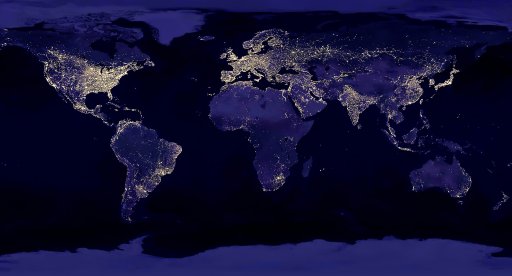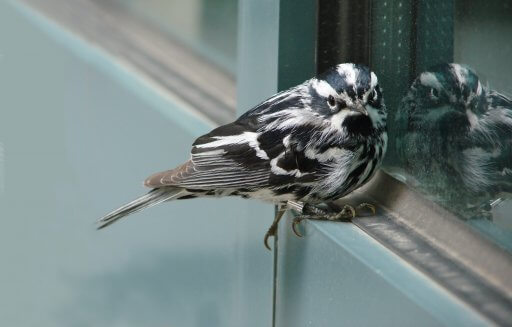Darkening the Night Skies Can Help Birds

As migration ramps up, hundreds of millions of birds, like the Indigo Bunting, are on their way north to their breeding grounds, mostly flying by night. Unfortunately, many won't make it to their intended, final destinations. Migration is a strenuous activity made all the more hazardous by artificial lights, especially at night. Nearly ubiquitous in the form of office tower fluorescents, light emanating from homes, and bright lights buzzing beside roads, artificial light can provide safety and comfort, but it can also be disruptive and even dangerous for wildlife. The bright lights of a city and even the glow of lights from a seemingly quiet suburban neighborhood can cause birds to become disoriented. Some, like the Black-and-white Warbler, will likely die after a collision with glass this season.

April 2 – 8, 2024 is International Dark Sky Week, a week of action and awareness to celebrate dark skies, take notice of the artificial light around us, and seek solutions for the well-being of animals and the planet. American Bird Conservancy's (ABC) Misguiding Light: The Role Artificial Light Plays in Bird Mortality from Collisions with Glass position statement offers science-backed recommendations for steering us toward safer skies, with information for the public and policymakers to help reduce light-related bird deaths.
“There is more and more scientific evidence of the pervasiveness of light pollution and its negative impact on birds,” said Christine Sheppard, ABC's Glass Collisions Program Director and author of the Misguiding Light position statement. “ABC has gathered this information, along with recommendations to help combat the problem and reduce bird mortality.”
Artificial light at night disorients migrating birds like the White-throated Sparrow and the Hermit Thrush, luring them toward and into urban centers. Once birds land near buildings, they are at increased risk of glass collisions, one of the most significant human-caused threats to birds in North America. The dangers posed to birds by artificial light spread as expanding development illuminates more of the night sky each year. By taking action to counteract light pollution, policymakers and the public can save many birds' lives.
Voluntarily darkening the night sky for birds — especially during migration — has gained traction since the first “Lights Out” efforts began in Chicago, Illinois, in 1995 and Toronto, Ontario, in 1997. Since then, dozens of cities in North America have adopted a Lights Out program, in which participating large buildings elect to turn off lights at night during migration seasons. These efforts are already helpful in reducing bird mortality around specific buildings, but legal requirements could make them even more effective and comprehensive. Regional- and national-level policies and ordinances can lead to more consistent and coordinated actions.
“Lights Out programs do a lot to inform the public and to reduce light pollution, but we need to do much more if we are to reverse current trends,” Sheppard said.
ABC recommends that more places in North America follow the lead of New York City and consider replacing or supplementing voluntary programs with policy solutions. Such solutions don't have to be confined to simply turning out the lights during migration. Changing the way we use lights at night can also make a big difference for birds.
“Smart” motion-sensing lights, for example, are a promising tool to cut down on bird collisions by automatically reducing light pollution. Also, studies have shown that turning off bright lights for short bursts when birds are circling overhead can “release” them back into the night. Another way to save birds is to permanently replace steady light sources with flashing or strobe lights. Thousands of communications towers have already modified their lights to be safer for birds, while maintaining aircraft safety and saving money on energy.
Of course, any strategy used to reduce dangerous lighting should also target light's accomplice: glass. While lights lure birds into the built environment, deceptive glass surfaces are the primary cause of subsequent deaths. New York City passed an excellent example of a bird-safe building law targeting glass in 2019. A 2023 report by ABC and the Law, Ethics and Animals Program (LEAP) at Yale Law School showed that cities are emerging as leaders in the effort to prevent birds from colliding with windows, with local laws and policies setting examples of the affordability and effectiveness of bird-friendly building design. In recent years, a number of cities, including Madison, Wisconsin and Washington, D.C., have passed bird-friendly building design ordinances.
ABC recommends that bird-friendly lighting policies be combined with bird-safe building measures to ensure that migratory birds' journeys aren't cut short with a split-second thud.
“Even if we could turn off every light at night, birds would still pass through the built environment in large numbers,” Sheppard said. “This makes it critical to promote and implement bird-friendly design as fundamental to the design process for all new buildings.”
Making the night skies safer for birds can start at home, and it can start with something as easy as flipping a switch.
- Turn off or dim unnecessary lighting inside and outside. Draw your blinds at night to keep light indoors and shut off decorative lighting outdoors.
- Make sure any outdoor lighting has a cover above it and aim it downward.
- Treat your windows to make them bird-friendly during the day. Explore a variety of solutions that can be easily installed or applied.
- Encourage your representatives to support legislation like the Federal Bird Safe Buildings Act and learn about efforts at the local level to reduce bird mortality from window collisions.
###
American Bird Conservancy (ABC) takes bold action to conserve wild birds and their habitats throughout the Americas. Inspired by the wonder of birds, we achieve lasting results for the bird species most in need while also benefiting human communities, biodiversity, and the planet's fragile climate. Our every action is underpinned by science, strengthened by partnerships, and rooted in the belief that diverse perspectives yield stronger results. Founded as a nonprofit organization in 1994, ABC remains committed to safeguarding birds for generations to come. Join us! Together, we can do more to ensure birds thrive.
Media Contact
Jordan Rutter
Director of Communications
media@abcbirds.org


















































